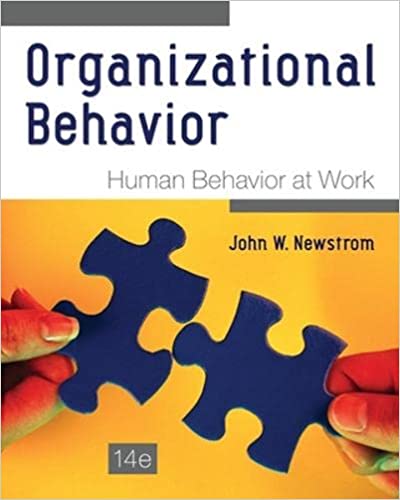
Organizational Behavior: Human Behavior at Work 14th Edition by John Newstrom
Edition 14ISBN: 978-0078112829
Organizational Behavior: Human Behavior at Work 14th Edition by John Newstrom
Edition 14ISBN: 978-0078112829 Exercise 3
The Excelsior Department Store
The Excelsior Department Store had a large department that employed six salesclerks. Most of these clerks were loyal and faithful employees who had worked in the department store more than 10 years. They formed a closely knit social group.
The store embarked on an expansion program requiring four new clerks to be hired in the department within six months. These newcomers soon learned that the old-timers took the desirable times for coffee breaks, leaving the most undesirable periods for newcomers. The old-time clerks also received priority from the old-time cashier, which required the newcomers to wait in line at the cash register until the old-timers had their sales recorded. A number of customers complained to store management about this practice.
In addition, the old-timers frequently instructed newcomers to straighten merchandise in the stockroom and to clean displays on the sales floor, although this work was just as much a responsibility of the old-timers. The result was that old-timers had more time to make sales and newcomers had less time. Since commissions were paid on sales, the newcomers complained to the department manager about this practice.
How is the informal organization involved in this case? Discuss.
The Excelsior Department Store had a large department that employed six salesclerks. Most of these clerks were loyal and faithful employees who had worked in the department store more than 10 years. They formed a closely knit social group.
The store embarked on an expansion program requiring four new clerks to be hired in the department within six months. These newcomers soon learned that the old-timers took the desirable times for coffee breaks, leaving the most undesirable periods for newcomers. The old-time clerks also received priority from the old-time cashier, which required the newcomers to wait in line at the cash register until the old-timers had their sales recorded. A number of customers complained to store management about this practice.
In addition, the old-timers frequently instructed newcomers to straighten merchandise in the stockroom and to clean displays on the sales floor, although this work was just as much a responsibility of the old-timers. The result was that old-timers had more time to make sales and newcomers had less time. Since commissions were paid on sales, the newcomers complained to the department manager about this practice.
How is the informal organization involved in this case? Discuss.
Explanation
Informal Organization:
The informal org...
Organizational Behavior: Human Behavior at Work 14th Edition by John Newstrom
Why don’t you like this exercise?
Other Minimum 8 character and maximum 255 character
Character 255


